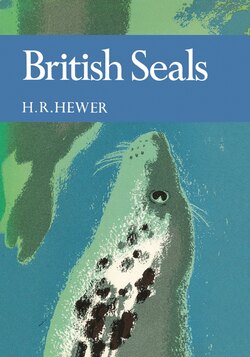Читать книгу British Seals - H. R. Hewer - Страница 9
EDITORS’ PREFACE
ОглавлениеSEALS are fascinating animals. Everyone knows what they look like, but most people, even some experienced naturalists, have only seen them alive in zoos, where the seals, and their relatives the sea lions, are such firm favourites with the crowds. It is not really difficult to see quite large numbers of both grey and common seals by visiting the correct coastal areas of Britain, but few casual visitors find themselves in the right place at the right time. The exception is the Farne Islands, where for many years great numbers of tourists have been able to see equally large numbers of grey seals, and to see the animals from boats without having to make the effort of walking long distances over sandy beaches and mud flats, or of scrambling energetically down steep and often treacherous cliffs.
Although seals are so well known, and are the subject of many fables and nursery tales, our knowledge of their life history and ecology was, until recently, very imperfect. We had little accurate knowledge of the size of their populations, and of whether they were increasing – as fishermen who believed they endangered their livelihood said – or whether they were in imminent danger of extinction – as some conservationists firmly insisted. Legislation on their protection, and efforts towards their control, were based on guesswork.
Professor Hewer would be the first to insist, as he does in several places in this book, that our knowledge is still imperfect and that much more research on these animals is still needed. But nevertheless our knowledge is now reasonably firmly based, and we are therefore glad to be able to publish this up to date and authoritative book at this time. We believe that, for the first time, it gives in one place the overall picture of these animals that many have been waiting for. It also enables the reader to understand the complex problems of seal conservation. Seals must be preserved, and this may sometimes include killing seals where (as in the Farne Islands) their numbers are too great for the habitat to support.
Professor Hewer modestly plays down his own contribution to our vastly increased knowledge of seals. He has himself, for over twenty years, been closely involved in all the major research in Britain. He has combined the careful laboratory investigations of the trained scientist with detailed studies of the animals, alive, in their natural habitats. As one fully employed as a university teacher (where his many students will testify to his conscientiousness) he has not always had the time or the opportunity to do, himself, all the experimental or observational work he would clearly have enjoyed, but all other workers in this field have gained so much from his freely given help and advice that his contribution to the whole subject has been unique. All other workers on British seals will readily acknowledge Professor Hewer as their spokesman.
Scientific knowledge of a subject is one thing, and this is the basis of this book, but its value is immensely enhanced by the fact that Professor Hewer really ‘knows’ seals. He has watched and lived alongside his subjects, and has come to know them as only one who is a skilled observer and a field naturalist can. These genuine observations on the living animals give this book a quality rarely found in works which also satisfy the most rigid canons of scientific accuracy.
